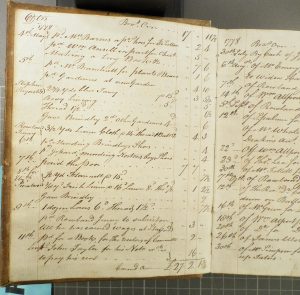In July 2020 the Journal for Eighteenth-Century Studies published my article on workhouse gardens.[1] Since then further information has come to light regarding the garden of St Mary’s Workhouse in Sandford Street, Lichfield.
The article noted that in 1769 Henry Rogers supplied the potatoes and kidney beans for the garden.[2] An entry in the overseers’ accounts for 19 July 1777 shows that the existing gardening operation was extended when the committee appointed to oversee the repair and extension of the workhouse for the ‘reception and employment of the poor’ accepted the offer ‘made generously by the Reverend Dr Falconer respecting a piece of Meadow Ground for a Garden’.[3]
 Figure 1: LD20/6/3, Lichfield St Mary’s, Overseers’ Account Book 1778-1784.
Figure 1: LD20/6/3, Lichfield St Mary’s, Overseers’ Account Book 1778-1784.
The accounts for 1778 show purchases for the garden and the payments made to labourers. In April thread for ‘garden line’ was purchased, presumably for marking out the ground. A Mr Bramhall was paid for plants and seeds. Other than ‘beans’, however, the specific types of plants and seeds are not listed. Gardeners were provided with ale. Wm Marklew was paid three shillings for two days’ work digging the new garden. In April and May ‘Brindley’ and others were also paid for unspecified garden work.
One of the crops was potatoes. On 30 October 1778 the workhouse received 5s 10d from a Mr Simpson for ‘Boys getting up Tatoes’. Although workhouse inmates were given ‘pay’ for any work they undertook in the new attic work room amounting to ‘two pence out of every shilling for their use’, it seems likely that in this instance the money went to the workhouse rather than directly to the boys.
With thanks to JK for the above image.
[1] Peter Collinge, ‘He shall have care of the garden, its cultivation and produce’: Workhouse gardens and gardening c.1780-1835’, Journal for Eighteenth-Century Studies, http://dx.doi.org/10.1111/1754-0208.12717.
[2] SRO, D3891/6/30/32, Henry Rogers, 27 May 1769.
[3] SRO, LD20/6/3, Lichfield St Mary’s Overseers’ Account Book 1778-1784.